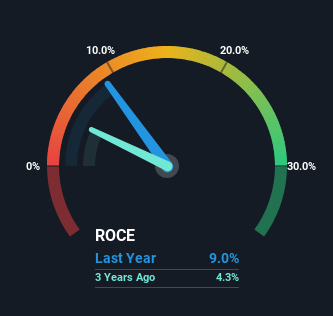
Finding a business that has the potential to grow substantially is not easy, but it is possible if we look at a few key financial metrics. In a perfect world, we'd like to see a company investing more capital into its business and ideally the returns earned from that capital are also increasing. Put simply, these types of businesses are compounding machines, meaning they are continually reinvesting their earnings at ever-higher rates of return. Although, when we looked at Quaker Chemical (NYSE:KWR), it didn't seem to tick all of these boxes.
Understanding Return On Capital Employed (ROCE)
Just to clarify if you're unsure, ROCE is a metric for evaluating how much pre-tax income (in percentage terms) a company earns on the capital invested in its business. Analysts use this formula to calculate it for Quaker Chemical:
Return on Capital Employed = Earnings Before Interest and Tax (EBIT) ÷ (Total Assets - Current Liabilities)
0.09 = US$215m ÷ (US$2.7b - US$352m) (Based on the trailing twelve months to September 2023).
Therefore, Quaker Chemical has an ROCE of 9.0%. On its own, that's a low figure but it's around the 10% average generated by the Chemicals industry.
View our latest analysis for Quaker Chemical

In the above chart we have measured Quaker Chemical's prior ROCE against its prior performance, but the future is arguably more important. If you're interested, you can view the analysts predictions in our free report on analyst forecasts for the company.
So How Is Quaker Chemical's ROCE Trending?
On the surface, the trend of ROCE at Quaker Chemical doesn't inspire confidence. To be more specific, ROCE has fallen from 18% over the last five years. However it looks like Quaker Chemical might be reinvesting for long term growth because while capital employed has increased, the company's sales haven't changed much in the last 12 months. It may take some time before the company starts to see any change in earnings from these investments.
The Key Takeaway
To conclude, we've found that Quaker Chemical is reinvesting in the business, but returns have been falling. And with the stock having returned a mere 6.1% in the last five years to shareholders, you could argue that they're aware of these lackluster trends. As a result, if you're hunting for a multi-bagger, we think you'd have more luck elsewhere.
If you'd like to know about the risks facing Quaker Chemical, we've discovered 3 warning signs that you should be aware of.
For those who like to invest in solid companies, check out this free list of companies with solid balance sheets and high returns on equity.
Valuation is complex, but we're here to simplify it.
Discover if Quaker Chemical might be undervalued or overvalued with our detailed analysis, featuring fair value estimates, potential risks, dividends, insider trades, and its financial condition.
Access Free AnalysisHave feedback on this article? Concerned about the content? Get in touch with us directly. Alternatively, email editorial-team (at) simplywallst.com.
This article by Simply Wall St is general in nature. We provide commentary based on historical data and analyst forecasts only using an unbiased methodology and our articles are not intended to be financial advice. It does not constitute a recommendation to buy or sell any stock, and does not take account of your objectives, or your financial situation. We aim to bring you long-term focused analysis driven by fundamental data. Note that our analysis may not factor in the latest price-sensitive company announcements or qualitative material. Simply Wall St has no position in any stocks mentioned.
About NYSE:KWR
Quaker Chemical
Quaker Chemical Corporation, doing business as Quaker Houghton, provides industrial process fluids for steel, aluminum, automotive, aerospace, offshore, can, mining, and metalworking companies worldwide.
Flawless balance sheet, undervalued and pays a dividend.


